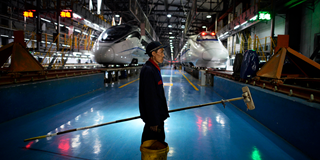In recent years, many of the world’s most influential countries have turned inward, with politicians promising protectionism, immigration restrictions, and even border walls. But, to achieve stronger economic growth and development, the world needs initiatives focused on building bridges – initiatives like China's Belt and Road.
NEW YORK – Since 2013, China has been pursuing its “Belt and Road” initiative, which aims to develop physical infrastructure and policy linkages connecting more than 60 countries across Asia, Europe, and Africa. Critics worry that China may be so focused on expanding its geopolitical influence, in order to compete with the likes of the United States and Japan, that it may pursue projects that make little economic sense. But, if a few conditions are met, the economic case for the initiative is strong.
As a recent Asian Development Bank report confirms, many Belt and Road countries are in urgent need of large-scale infrastructure investment – precisely the type of investment that China has pledged. Some, such as Bangladesh and Kyrgyzstan, lack reliable electricity supplies, which is impeding the development of their manufacturing sectors and stifling their ability to export. Others, like Indonesia, do not have enough ports for internal economic integration or international trade.
The Belt and Road initiative promises to help countries overcome these constraints, by providing external funding for ports, roads, schools, hospitals, and power plants and grids. In this sense, the initiative could function much like America’s post-1945 Marshall Plan, which is universally lauded for its contribution to the reconstruction and economic recovery of war-ravaged Europe.

NEW YORK – Since 2013, China has been pursuing its “Belt and Road” initiative, which aims to develop physical infrastructure and policy linkages connecting more than 60 countries across Asia, Europe, and Africa. Critics worry that China may be so focused on expanding its geopolitical influence, in order to compete with the likes of the United States and Japan, that it may pursue projects that make little economic sense. But, if a few conditions are met, the economic case for the initiative is strong.
As a recent Asian Development Bank report confirms, many Belt and Road countries are in urgent need of large-scale infrastructure investment – precisely the type of investment that China has pledged. Some, such as Bangladesh and Kyrgyzstan, lack reliable electricity supplies, which is impeding the development of their manufacturing sectors and stifling their ability to export. Others, like Indonesia, do not have enough ports for internal economic integration or international trade.
The Belt and Road initiative promises to help countries overcome these constraints, by providing external funding for ports, roads, schools, hospitals, and power plants and grids. In this sense, the initiative could function much like America’s post-1945 Marshall Plan, which is universally lauded for its contribution to the reconstruction and economic recovery of war-ravaged Europe.